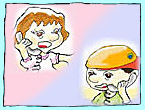Communicative functions: Interacting with others
| Using formulaic expressions |
Introduction
| When we interact with others, we often use formulaic expressions. These
are expressions which are fixed and always used in the same way at the same point in an interaction. In
other words, formulaic expressions are routines we go through at particular
points in an interaction. For example, at the beginning of a spoken interaction
when we greet someone, we choose from several formulaic expressions such as Hello,
Good Morning or Hi.
We usually use formulaic expressions to do the
following: |

|
| Greet people and introduce ourselves: "Hi Ricky. It's Kitty." | |
| Start a conversation: "Know what?" | |
| Keep a conversation going: "Know what?" "What?" | |
| Keep track of information in a conversation: "Our pool's empty!" "Empty?" | |
| Agree, disagree, show approval or give encouragement: "Weird!" "Yeah it is." | |
| Offer thanks, good wishes, congratulations, concern and sympathy: "Thanks Kitty." | |
| Express and respond to apologies, regrets and excuses: "Sorry Ricky. I have to go." | |
| Close a conversation: "Bye" "Bye" |
We also use idioms and figurative language in social interactions. Idioms and figurative language also tend to be fixed expressions.
For more information about formulaic expressions, see:
![]() Text
types: Texts for social interaction: Overview: The language of social interaction
Text
types: Texts for social interaction: Overview: The language of social interaction
Teaching activities |
|
For PrimeTeach teaching activities which provide KS2 students
with practice in using formulaic expressions, see:
|
|
||
To give us feedback about this section, click here or on the Comment button at the top of the screen.
If you have any questions about this section, visit the Language Corner.
If you have any questions or suggestions about how to teach this section, send a message to the Teaching Corner.